When you decide to start gardening, garlic is probably the best choice for you since there are no many vegetables that are so simple to grow and harvest. It requires low maintenance, needs not much space (you can grow this veggie even in a container), and tastes great. Try to buy garlic sets from a local supplier, garden center, or make a mail-order from renowned supplier to get the best results.
In general, you need to plant a chosen variety of garlic outdoors at the right time (spring or mid-fall), and to determine the adequate ground and sunny site for this purpose. Actually, the best time to plant this crop is in mid-autumn after harvesting most summer vegetables. That way, you can collect it next summer.
Basic Data about Garlic
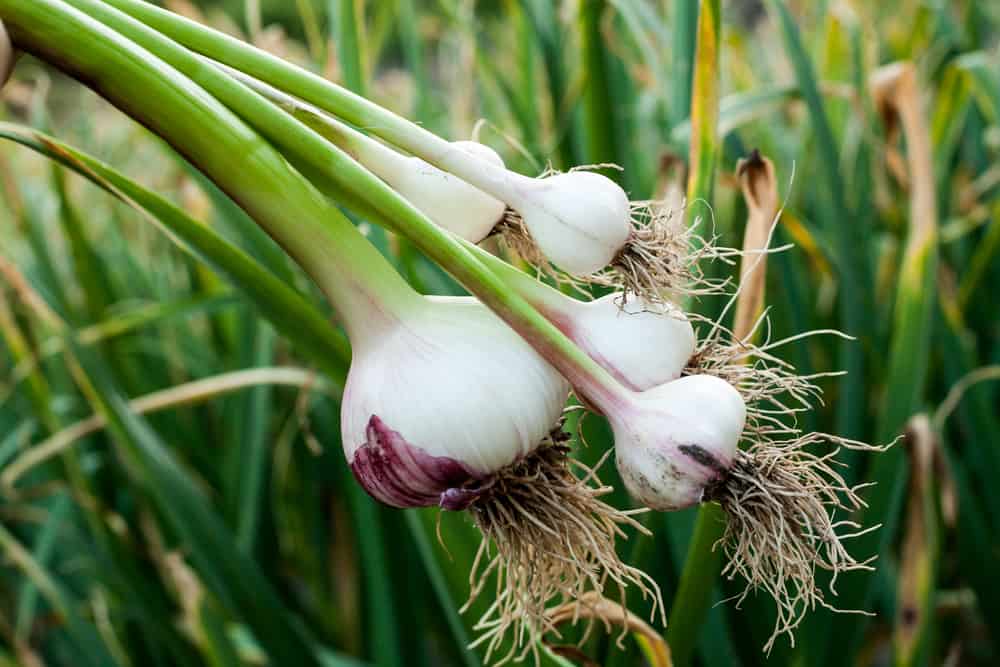
Your garlic will grow from individual cloves after you break it off from its bulb. After planting cloves, you can expect that they multiply in the ground and form new bulbs consisted of five to ten fresh cloves each.
Since garlic is highly delicious, you can use it as a flavoring in many recipes. However, that is not all. This useful veggie has been used as a home remedy for centuries and an insect repellent as well.
There are a few subspecies and varieties of Allium sativum, including:
- Two subspecies
- Ten major groups of different varieties
- Hundreds of varieties or cultivars.
The most gardeners choose three types of varieties of garlic to grow:
- Allium sativum var. ophioscorodon (Ophioscorodon, hardneck garlic)
It includes rocambole, porcelain, and purple-stripe garlic. This type is extremely cold hardy, but you can store it just for a short period.
- Allium sativum var. sativum (softneck garlic)
It includes artichoke, Creole, and silverskin garlic. You should pick out this type if you live in warmer climes.
- Allium ampeloprasum var. ampeloprasum (Great-headed, elephant)
This type is not real garlic. It is less hardy and doesn’t have the traditional garlic flavor. Basically, you can consider it a variant of the garden leek.
Reasons Why Do You Need to Grow Garlic in Your Garden
Garlic has been recognized as food and medicine since ancient times. Modern scientists confirmed many effects of garlic, which are beneficial for our health. Let’s see.
Garlic is a highly nutritious veggie with very few calories
This vegetable is incredibly nutritious and comes with just 42 calories. In accordance with Recommended Dietary Allowance (RDA), a 1 ounce (28.3 g) contains:
- 23% (of the RDA) of manganese
- 17% (of the RDA) of vitamin B6
- 15 % (of the RDA) of vitamin C: 15%
- 6 % (of the RDA) of selenium
There are also:
- Vitamin B1
- 02 ounces (0.6 g) of fiber
- 06 ounces (1.8 g) of protein
- 3 ounces (9 g) of carbs
- Calcium
- Copper
- Iron
- Potassium
- Phosphorus
All in all, garlic contains a little bit of almost every nutrient you need during a day.
Garlic has a lot of potent medicinal properties
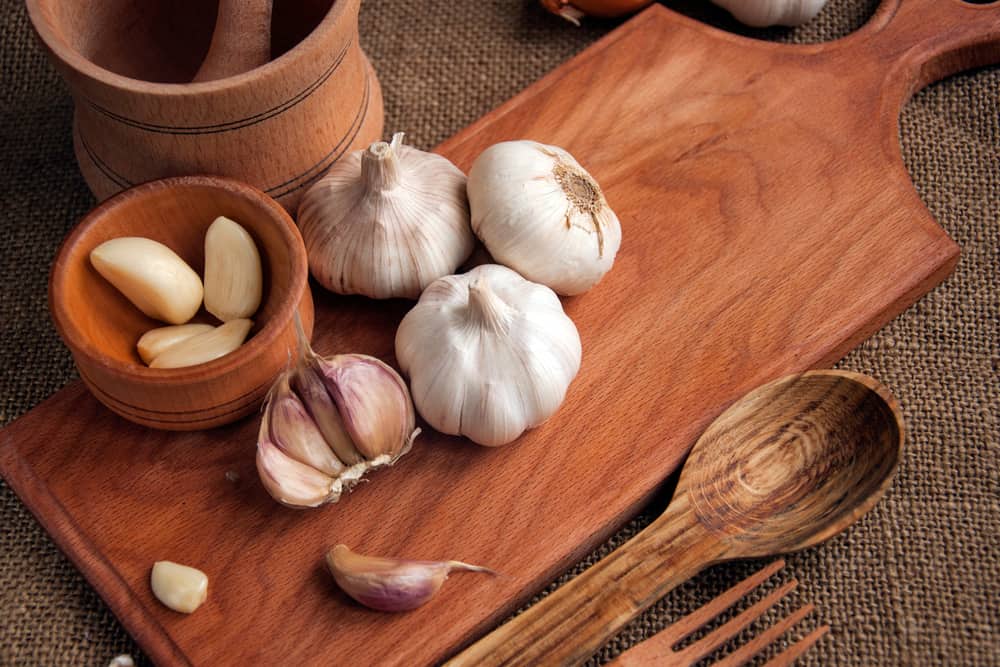
Many major civilizations (Babylonians, Egyptians, Chinese, Romans, and Greeks) documented the medical use of garlic. Nowadays, scientists know that the health benefits of garlic are caused by sulfur compounds. They start forming as soon as we chew, chop, or crush this veggie.
The primary sulfur compound in garlic is allicin. It is quite unstable, and you can find it just for a while in crushed and cut fresh garlic. There are also S-allyl cysteine and diallyl disulfide, which are also beneficial for our health.
Garlic will boost the function of your immune system, and the results of many relevant studies show that a daily garlic intake may:
- Reduce the appearance of colds by 63%
- Reduce the average length of cold symptoms to 1.5 days
- Lower total and LDL cholesterol (without significant effects on levels of triglyceride and HDL cholesterol)
- Reduce blood pressure
- Lower the risk of heart disease
- Improve bone health
- Help prevent dementia and Alzheimer’s disease (antioxidants it contains will reduce free radicals, and consequently decrease oxidative damage and the aging process)
- Lower the risk of developing some types of cancer
- Help the detoxification of heavy metals (including lead) from your body
- Improve your athletic performance since it will reduce fatigue and your increase work capacity
- Help you live longer
- When consumed in its raw form, garlic is believed to have a more potent impact on testosterone levels. Garlic for men is thus an excellent choice to enhance their hormone levels naturally.
How to Plant Garlic in Your Garden
Garlic is not a complicated veggie for planting. You just need to provide some underlying conditions for its healthy growth, and you can expect an abundant harvest.
When to plant garlic
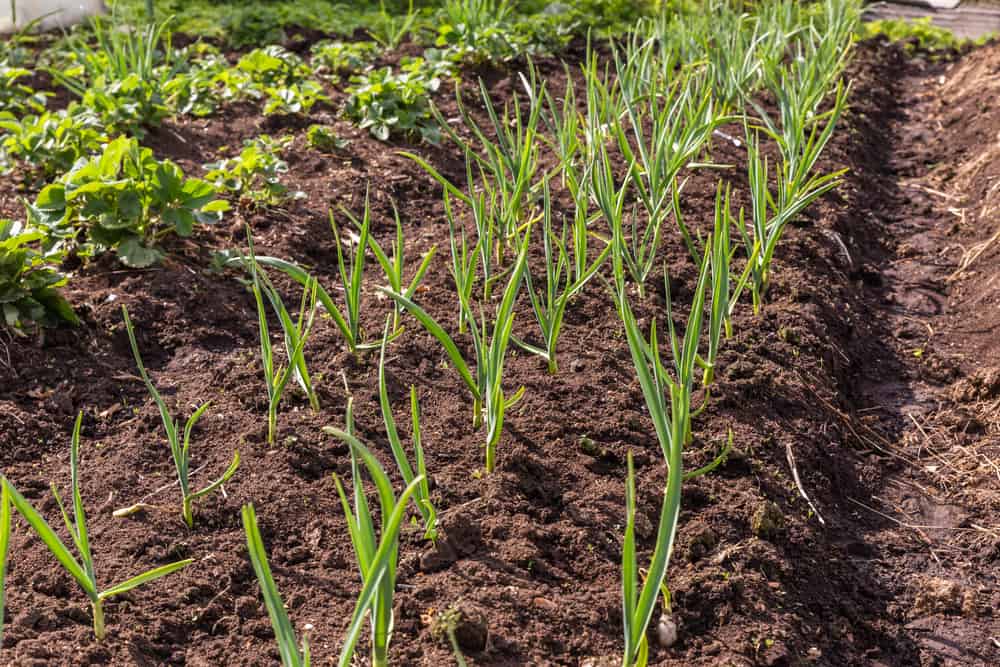
The best decision is planting garlic cloves between September and November if you live in northern climates. Most gardeners agree that planting garlic before Christmas will bring the best results.
However, if you live in southern areas, you should plant this veggie between February and March for the best results.
If a hard frost is usual in your region, you need to plant your garlic at least a month and a half before the date of the first expected fall frost. Your goal is to let garlic develop stable roots before the soil entirely freezes. An ideal temperature required in that period is 40F (4.5 C).
Prepare the soil
For successful planting your garlic, you need to provide a spot with full sun and the well-drained ground. An ideal pH of the soil is about 5.5 to 7, and you can achieve it by adding adequate fertilizer.
To make it looser, you should dig the soil with a fork a bit and spread a layer of 2 to 3 inches (5 – 7.6 cm) of mulch or organic compost over the top. Avoid using fresh animal manure as mulch.
It is essential not to plant garlic in the same spot twice consecutive. In general, you should make an excellent system of your crops rotation, and avoid places where water collects around the roots. Those are good ways to prevent rot and some disease problems.
Pick out the largest cloves you can find, and you can expect to harvest large bulbs the following summer.
How to plant garlic
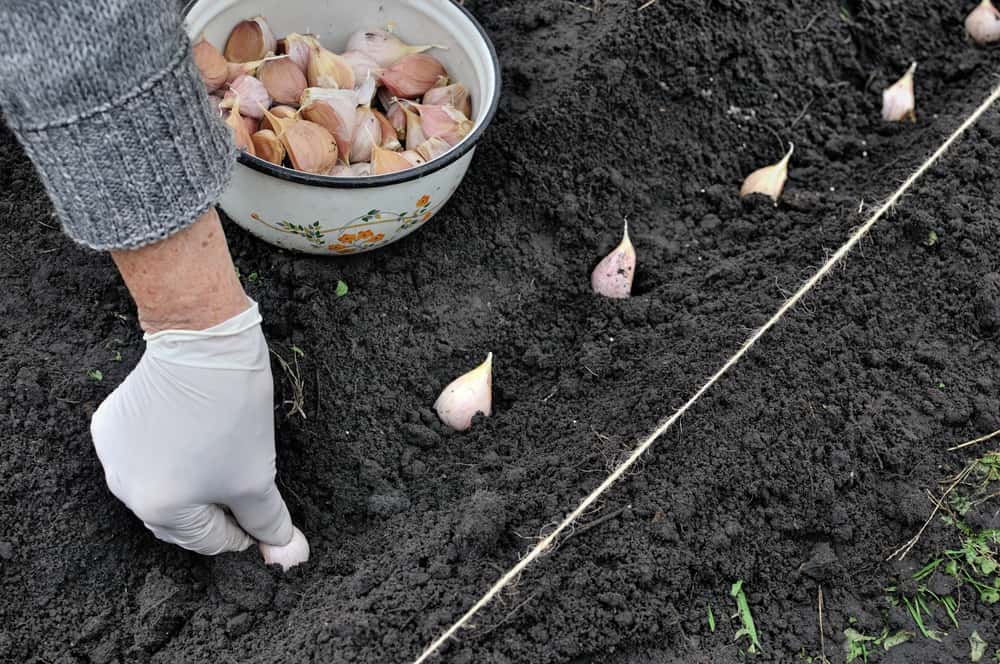
It is best to separate cloves and use the freshest and biggest ones for planting.
You need a sunny place with loose, fertile, and well-drained soil. Once you pick out the right spot, put cloves approximately 1-3 inches (2.5 – 7.6 cm) deep and 4 to 6 inches (10 – 15 cm) apart. The pointed end of the clove should be faced up.
Don’t forget to cover them with 1 to 2 inches (2.5 – 5 cm) of soil. If you live in one of the North States, you should add 6 inches (15 cm) of mulch or slow-release fertilizer on the top for winter protection. Your rows should be 11 to 15 inches (28 – 38 cm) apart.
How to care garlic in your garden
1. Fertilizing
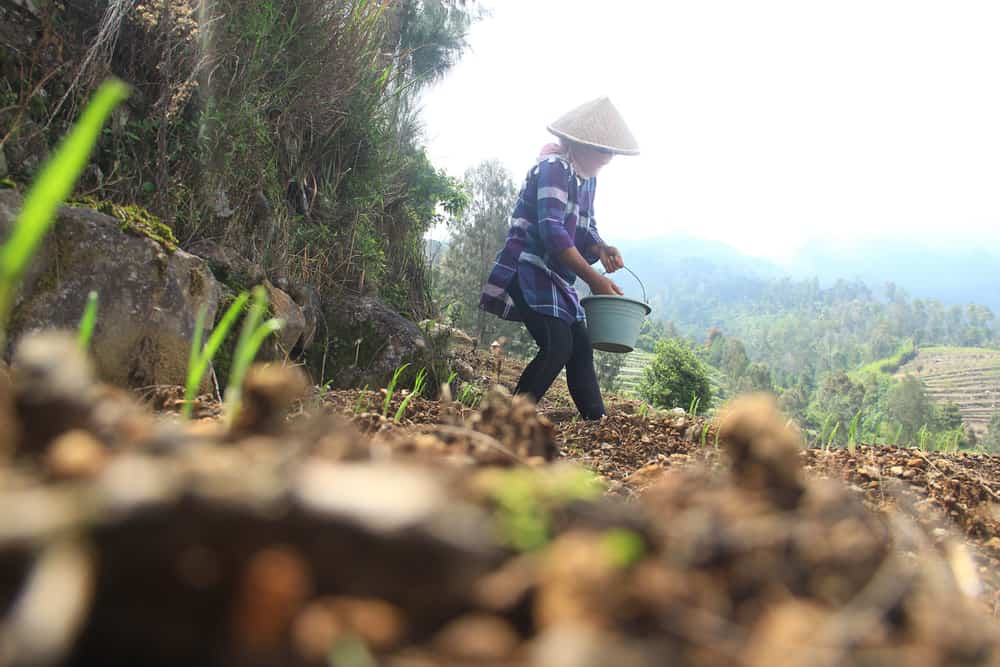
Depending on the region, you will see the first growth of leaves in early spring. It is the perfect period for applying a nitrogen-based fertilizer to fat out the bulbs. In average, you will need 1 ounce (28 g) of general-purpose fertilizer per 10.8 sq. feet (1 m2) of your yard.
The best option is to use liquid kelp and fish emulsion. Fertilize your garlic twice. The first moment is the period when plants start thriving. It is usually in April, but the exact timing depends on the region you live in. Repeat fertilizing about a month later, and it will be enough for one growing season.
2. Watering
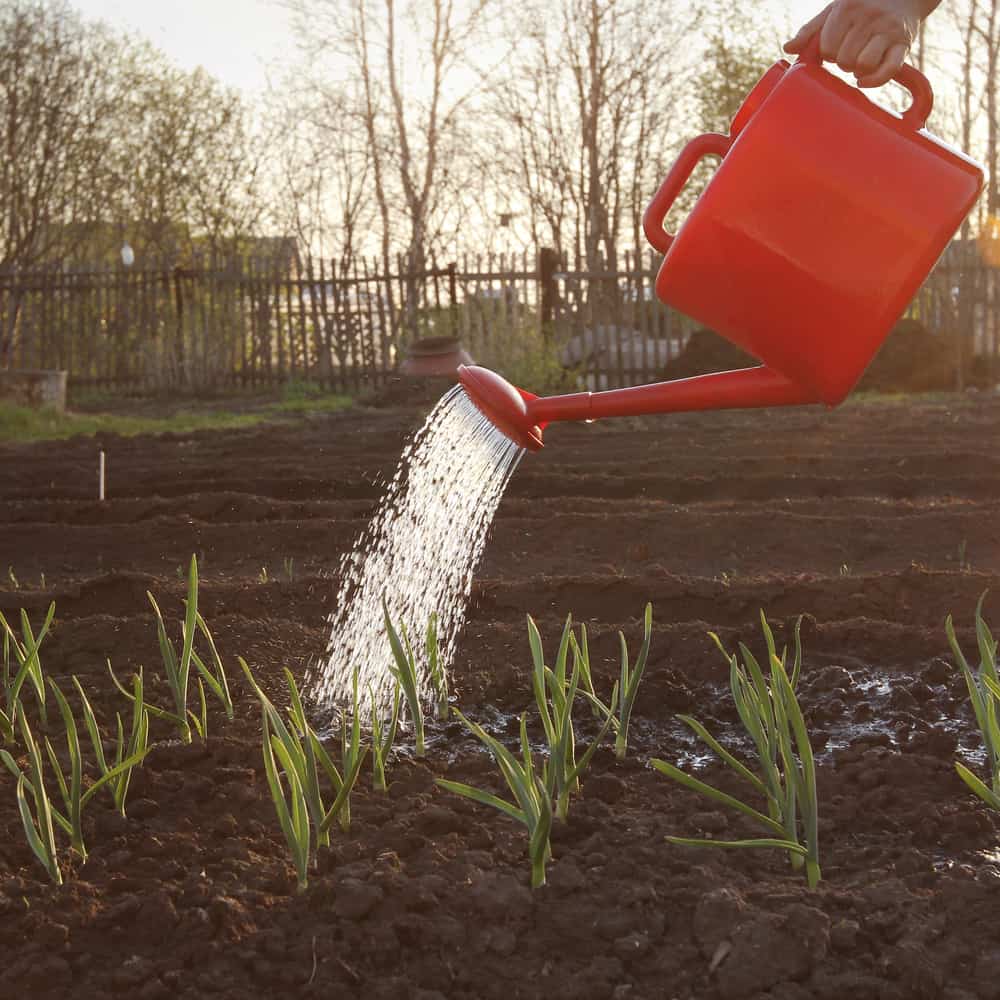
You don’t need to water the soil approximately two weeks after planting and until germination of the cloves. After that, you can water your garlic often enough to keep the soil moist.
It is a good idea to lay down a mulch of straw over the ground to protect your plants and keep them moist. At the same time, the layer thick about 4 inches (10 cm) will keep your garlic safe from freezing.
Keep in mind that your garlic doesn’t like highly moist soil, but it won’t grow correctly if it is too dry either. You can determine the right moment for watering by checking the humidity of the ground.
When the soil is dry 1 inch (2.5 cm) under the surface, it is the time for watering. When cloves start to form, you should finish with watering until the time of harvesting.
3. Weeding
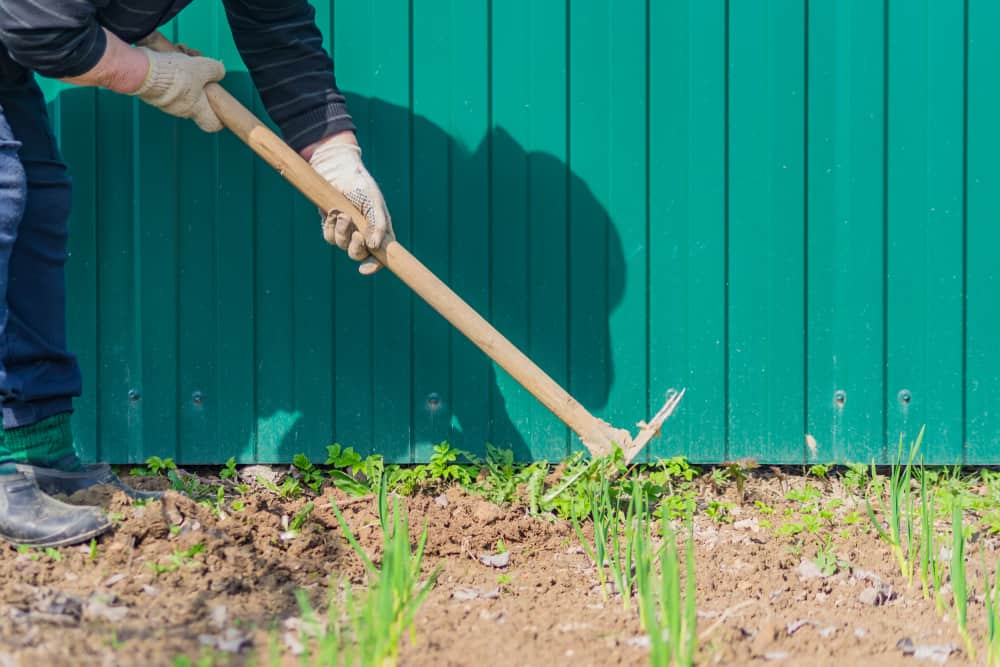
Garlic is pretty vulnerable when it comes to weeds. Since hoeing weeds may damage developing bulbs, you will need to finish the job by using your own hands as soon as weeds appear. Keep the part of the garden with planted garlic weeds-free, and it will pay off.
4. Cutting garlic scapes
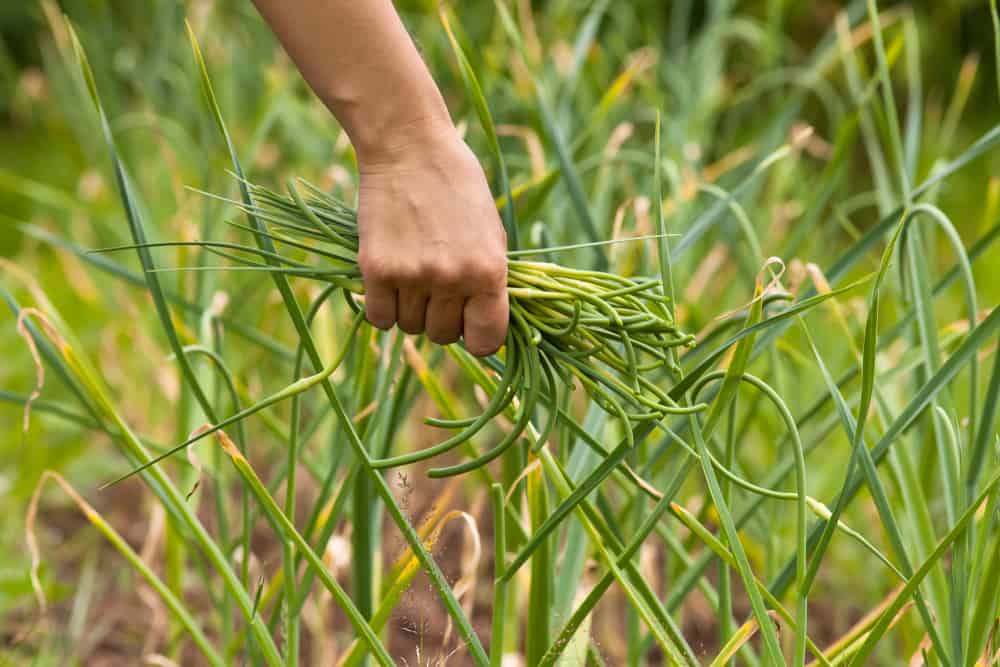
To avoid garlic scapes draw energy from the bulbs, you need to cut them regularly. Don’t throw them away after cutting! They are actually pretty delicious, plus you can put them in the vase and get an extraordinary decoration.
Basically, you can eat them until they become too large. Scapes long between 4 to 6 inches (10 – 15 cm) have the best texture and flavor.
If you decide to cut some scapes for a vase, take care to do that on time. If you cut them too soon, you won’t get well-developed tops. After they develop correctly, you will also get heads of tiny garlic grains. You can eat them without peeling.
On the other hand, you can find top-sets (a clump of small round bulbs) which you can store during winter and planted them in early spring. That way, you will produce the garlic equivalent of scallions.
Harvesting and Storing Garlic
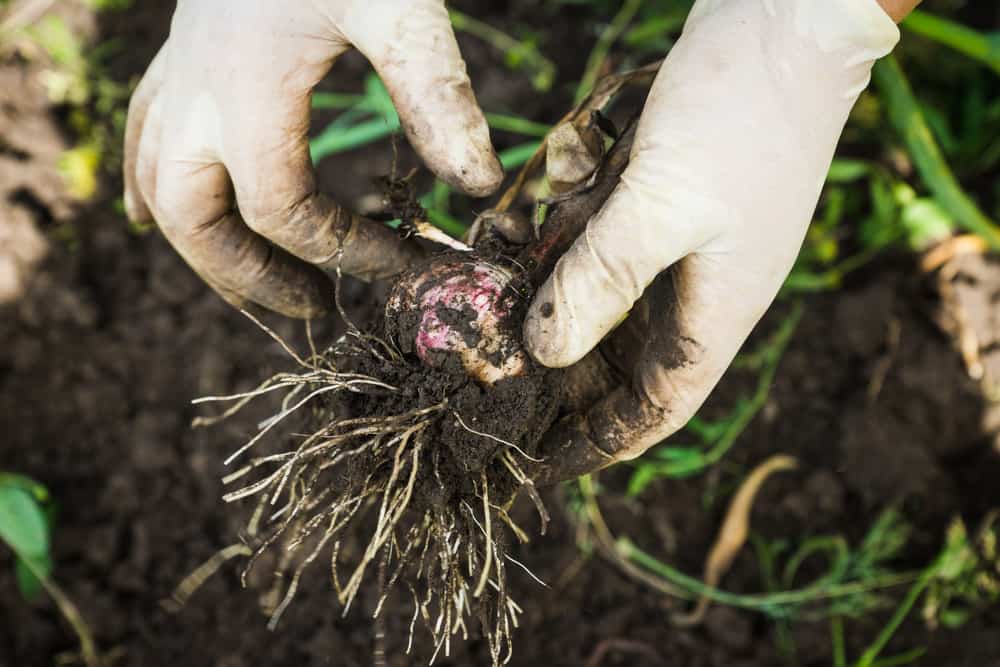
You can expect to harvest your garlic approximately seven to eight months after planting. An ideal period is in late spring or early summer, but in most regions, you can pick up your garlic in late July.
You will know that it is the right time when spotting five to six green leaves. To avoid damaging bulbs while harvesting, you should drive a garden fork beneath it. Pry them loose gently and pull the plant out.
You can expect to harvest about 5 pounds (2.3 kg) of the bulbs in every 10 feet (3 m) long row. Place the harvested plants to an airy location and take care to protect them from sun and rain.
The ideal temperature for storing your garlic is from 55 and 70 F (13 – 21 C). Also, you need to provide excellent aeration as well as enough light and moderate humidity for bulbs. Avoid letting them on direct sunlight, over-drying, and storing bulbs in a plastic bag to prevent rotting.
Problems with Pests
Since it is a natural pest repellent, garlic has no many problems with pests, and it is not generally prone to diseases. Some of the probable issues are:
White rot
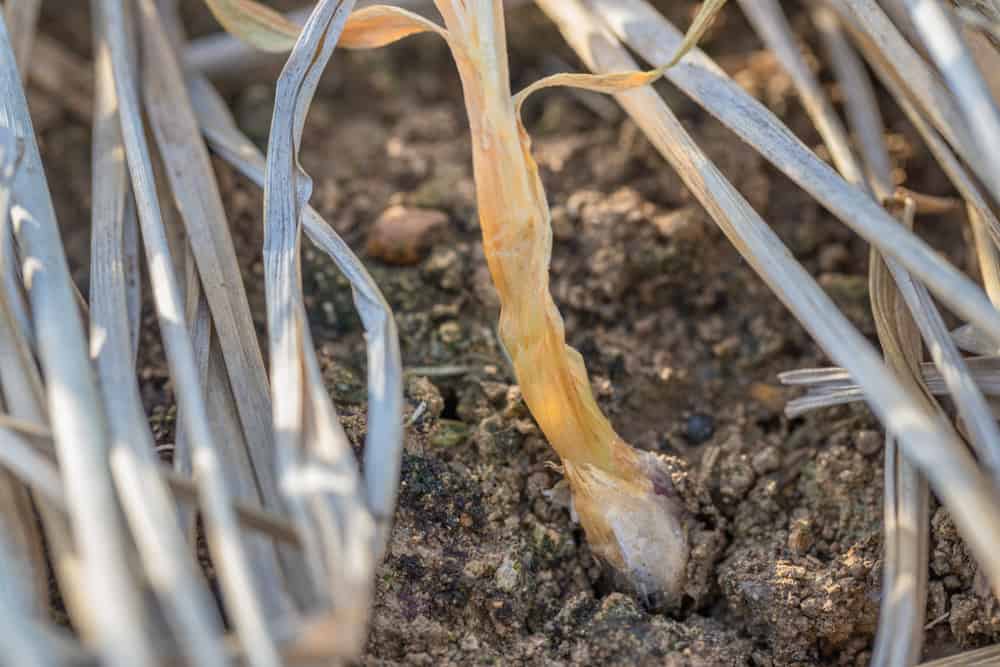
This fungus may attack your garlic at low temperatures, and you can’t do much to prevent that issue. Try to rotate crops regularly and clean up the place properly after harvesting since the spores can survive in the soil for years.
Leek rust
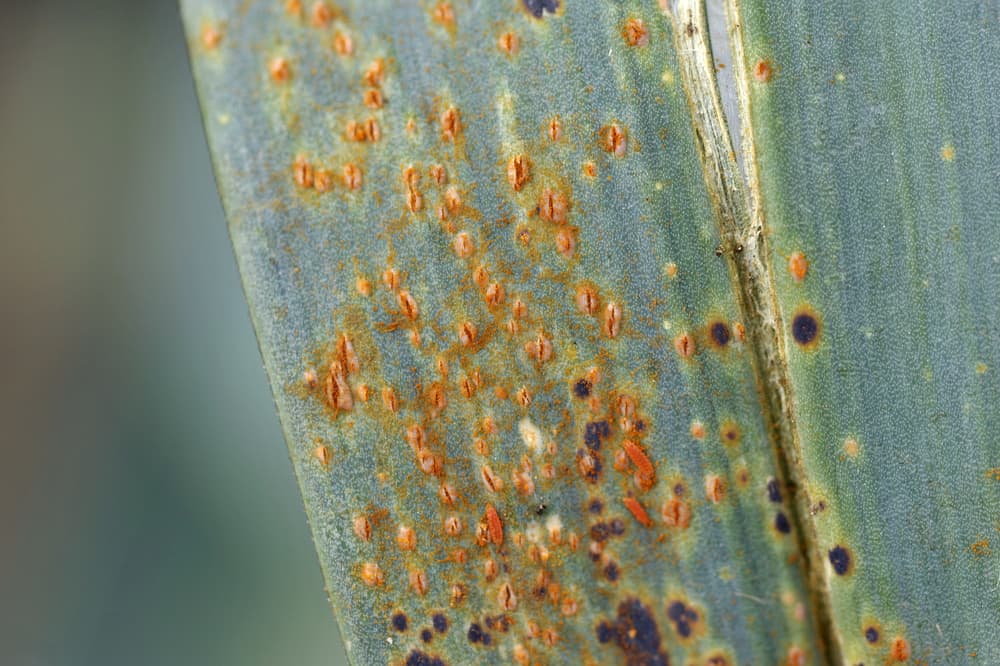
These fungi won’t harm garlic, but they will cause bright yellow spots on its leaves during long periods of rain and affect yield. The only thing you can do is to prevent high humidity and rotate crops regularly.

Leave a comment